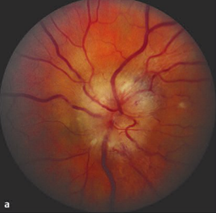Questions:
1. What are the ophthalmoscopic characteristics of neuroretinitis?
2. Is neuroretinitis caused by demyelination?
3. In what settings does neuroretinitis most commonly occur?
 1
1
____________________________________________________
Questions with answers:
1. What are the ophthalmoscopic characteristics of neuroretinitis?
Neuroretinitis is characterized ophthalmoscopically by optic disc swelling associated with a macular star figure composed of lipid.
2. Is neuroretinitis caused by demyelination?
No. This form of optic neuritis is not caused by demyelination.
3. In what settings does neuroretinitis most commonly occur?
Neuroretinitis occurs most often in the setting of cat scratch disease or in association with other systemic infectious diseases, such as Lyme disease, and syphilis, as well as with sarcoidosis.
Explanation:
“Neuroretinitis
Neuroretinitis associated inflammation of the optic nerve head with retinal lesions. It is characterized ophthalmoscopically by optic disc swelling associated with a macular star figure composed of lipid. The retinal abnormalities typically appear days to weeks after the onset of visual loss. This form of optic neuritis is not caused by demyelination and occurs most often in the setting of cat scratch disease or in association with other systemic infectious diseases, such as Lyme disease and syphilis, as well as with sarcoidosis. These patients are not at subsequent risk for the development of multiple sclerosis (▶Fig. 8.14 and ▶Fig. 8.15).

 “1
“1
Reference:
1. Neuro-ophthalmology Illustrated-2nd Edition. Biousse V and Newman NJ. 2012. Theme
These questions are archived at https://neuro-ophthalmology.stanford.edu
Follow https://twitter.com/NeuroOphthQandA to be notified of new neuro-ophthalmology questions of the week.
Please send feedback, questions and corrections to tcooper@stanford.edu.